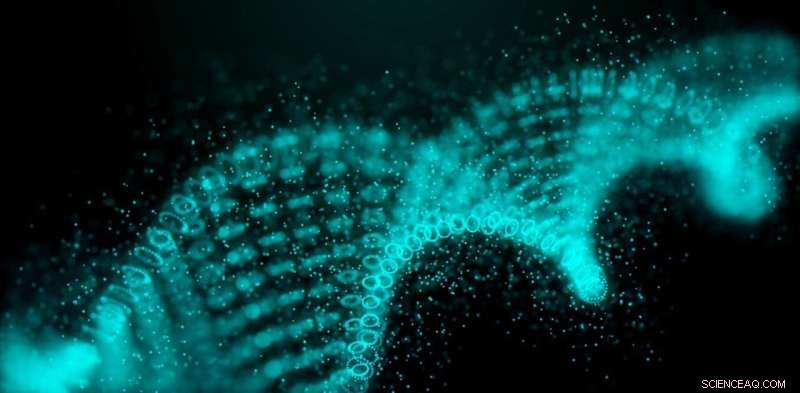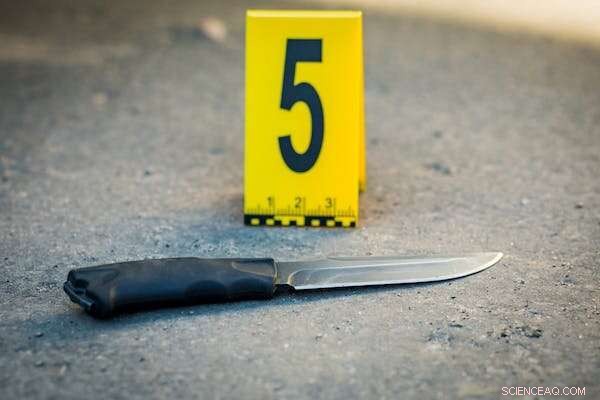O DNA é frequentemente usado na resolução de crimes. Mas como o perfil de DNA realmente funciona?

Crédito:thinkhubstudio/Shutterstock
O perfil de DNA é frequentemente notícia. O interesse público é despertado quando o DNA é usado para identificar um suspeito ou restos humanos, ou resolve um caso arquivado que parece quase esquecido.
Muito ocasionalmente, está na mídia quando o processo não funciona como deveria.
Então, o que é o perfil de DNA e como ele funciona – e por que às vezes não funciona?
Uma breve história do perfil de DNA O perfil de DNA, como é conhecido desde 1994, tem sido usado no sistema de justiça criminal desde o final da década de 1980 e foi originalmente denominado "DNA fingerprinting".
O DNA em cada ser humano é muito semelhante – até 99,9% idêntico, na verdade. Mas, estranhamente, cerca de 98% do DNA em nossas células não está relacionado a genes (ou seja, não tem função conhecida).
Esse DNA não codificante é composto em grande parte por sequências das quatro bases que compõem o DNA em cada célula.
Mas por razões desconhecidas, algumas seções da sequência são repetidas:um exemplo é TCTATCTATCTATCTATCTA onde a sequência TCTA é repetida cinco vezes. Embora o número de vezes que essa sequência de DNA é repetida seja constante dentro de uma pessoa, ela pode variar entre as pessoas. Uma pessoa pode ter 5 repetições, mas outra 6, ou 7 ou 8.
Há um grande número de variantes e todos os humanos se enquadram em uma delas. A detecção dessas repetições é a base do perfil de DNA moderno. Um perfil de DNA é uma lista de números, com base nas sequências repetidas que todos temos.
O uso dessas sequências de repetição curta (o termo técnico é "repetição em tandem curta" ou STR) começou em 1994, quando o Serviço de Ciência Forense do Reino Unido identificou quatro dessas regiões. A chance de que duas pessoas escolhidas aleatoriamente na população compartilhassem os mesmos números repetidos nessas quatro regiões era de cerca de 1 em 50.000.
Agora, o número de sequências repetidas conhecidas se expandiu bastante, com o teste mais recente analisando 24 regiões STR. O uso de todas as regiões STR conhecidas resulta em uma probabilidade infinitesimalmente pequena de que duas pessoas aleatórias tenham o mesmo perfil de DNA. E aqui reside o poder do perfil de DNA.
Como é feito o perfil de DNA? A sequência repetida será a mesma em todas as células de uma pessoa - assim, o perfil de DNA de uma amostra de sangue será o mesmo de um cabelo arrancado, dentro de um dente, saliva ou pele. It also means a DNA profile will not in itself indicate from what type of tissue it originated.
Consider a knife alleged to be integral to an investigation. A question might be "who held the knife"? A swab (cotton or nylon) will be moistened and rubbed over the handle to collect any cells present.

Swabbing an item left at a crime scene can easily yield enough cells to generate a DNA profile. Credit:Fuss Sergey/Shutterstock
The swab will then be placed in a tube containing a cocktail of chemicals that purifies the DNA from the rest of the cellular material—this is a highly automated process. The amount of DNA will then be quantified.
If there is sufficient DNA present, we can proceed to generate a DNA profile. The optimum amount of DNA needed to generate the profile is 500 picograms—this is really tiny and represents only 80 cells!
How foolproof is DNA profiling? DNA profiling is highly sensitive, given it can work from only 80 cells. This is microscopic:the tiniest pinprick of blood holds thousands of blood cells.
Consider said knife—if it had been handled by two people, perhaps including a legitimate owner and a person of interest, yet only 80 cells are present, those 80 cells would not be from only one person but two. Hence there is now a less-than-optimal amount of DNA from either of the people, and the DNA profiling will be a mixture of the two.
Fortunately, there are several types of software to pull apart these mixed DNA profiles. However, the DNA profile might be incomplete (the term for this is "partial"); with less DNA data, there will be a reduced power to identify the person.
Worse still, there may be insufficient DNA to generate any meaningful DNA profile at all. If the sensitivity of the testing is pushed further, we might obtain a DNA profile from even a few cells. But this could implicate a person who may have held the knife innocently weeks prior to an alleged event; or be from someone who shook hands with another person who then held the knife.
This later event is called "indirect transfer" and is something to consider with such small amounts of DNA.
What can't DNA profiling do? In forensics, using DNA means comparing a profile from a sample to a reference profile, such as taken from a witness, persons of interest, or criminal DNA databases.
By itself, a DNA profile is a set of numbers. The only thing we can figure out is whether the owner of the DNA has a Y-chromosome—that is, their biological sex is male.
A standard STR DNA profile does not indicate anything about the person's appearance, predisposition to any diseases, and very little about their ancestry.
Other types of DNA testing, such as ones used in genealogy, can be used to associate the DNA at a crime scene to potential genetic relatives of the person—but current standard STR DNA profiling will not link to anyone other that perhaps very close relatives—parents, offspring, or siblings.
DNA profiling has been, and will continue to be, an incredibly powerful forensic test to answer "whose biological material is this"? This is its tremendous strength. As to how and when that material got there, that's for different methods to sort out.

